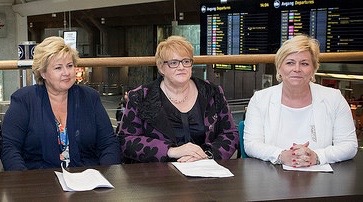NEWS ANALYSIS: After weeks of discussions, Norway’s Liberal Party is moving forward with efforts to join the country’s conservative minority coalition government. The move still won’t leave an expanded coalition with a majority in Parliament, but all three parties and others involved now see advantages of working together in a new government.

There are still enough disadvantages that state broadcaster NRK reported Sunday that fully a third of the Liberal’s own national board members voted against launching formal negotiations to join the government. Not even one of the Liberals’ two deputy leaders, Terje Breivik, is keen on the idea, with his skepticism confirmed during party meetings over the weekend. While the Liberals have a history of cooperating well with the Conservatives, many fear it will be too difficult for the Liberals to cooperate in government with the Progress Party on areas such as immigration and asylum. Others feel the Liberals can be more visible and independent outside the government than in it.
‘Give us a chance’
The Liberals’ leader Trine Skei Grande, however, asked her party’s internal skeptics and voters to “give us a chance” at sharing government power. She sees potential for making Norway’s government and oil-fueled economy “greener,” and she ultimately won majority support from her party’s parliamentary delegation. That gave her the green light to move forward with actual government negotiations.
If successful, the negotiations will give the Liberals political control over at least a few government ministries, probably at the expense of the Progress Party, which acts as the Conservatives’ junior partner in the current conservative government coalition. The negotiations can also give the Liberals more power to influence government policy before it reaches Parliament.

Newspaper Dagens Næringsliv (DN), for example, noted on Monday that the current two-party coalition could benefit from the Liberals’ ideas and policies in areas such as education, cooperation with the EU, small business and entrepreneurship. The Liberals are also among the most reform-minded parties in Parliament, and that could mesh well with reform policies pushed by both the Progress Party and the Conservatives.
The Liberals may also be able to push even the Progress Party towards more climate-friendly policies. That would be more likely to win support from at least the centrist Christian Democrats party, which has decided to remain as part of the opposition in Parliament and can often have the powerful swing vote on key issues. The Liberals get along well with the Christian Democrats, and together had a formal cooperation agreement with the Conservatives and Progress during the last parliamentary session. If the Liberals become part of government, they can potentially hammer out positions with the Conservatives and Progress parties while working with the Christian Democrats on the side.
Confusing names and positions
It’s important to note that despite the party’s “Liberal” name in English and its Norwegian name of Venstre (which literally translates into English as “Left”), the Liberals are in reality a centrist party on the non-socialist (right) side of Norwegian politics. Their role can thus be confusing to non-Norwegian observers and often to Norwegians as well, because of their history of changing positions on issues. Grande defends what some call the party’s “waffling” over the years with its aim of always trying to get the most out of its politics at any given moment.
It’s also important to remember that both the Liberals and the Christian Democrats remain small parties, winning just 4.4 and 4.2 percent of the vote respectively in the September election. That was enough to give them both representation in Parliament but only barely, and both have since slipped below the 4 percent needed in recent public opinion polls. The Liberals held just 3.4 percent of the vote, and the Christian Democrats 3.9 percent in last week’s “party barometer” conducted by research bureau Opinion for news bureau ANB. It can thus be argued that remaining on their own in Parliament hasn’t helped either party much in appealing to voters.
Prime Minister Erna Solberg, whose Conservative Party has gained in recent polls and now holds around 26 percent of the vote, will have the final say in what kind of government power the Liberals may acquire and how a new three-party coalition government will look. All involved claim it’s too early to say how many ministerial posts the Liberals will gain or who will fill them, and speculation is already flying.
Solberg, Progress Party leader and Finance Minister Siv Jensen and the Liberals’ Grande all said on NRK’s popular debate program Politisk kvarter Monday morning that a new government, if they agree on one, isn’t likely to be unveiled until after New Year.
newsinenglish.no/Nina Berglund

